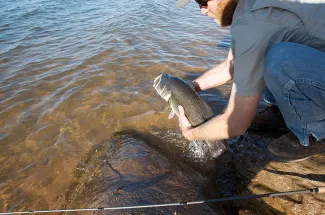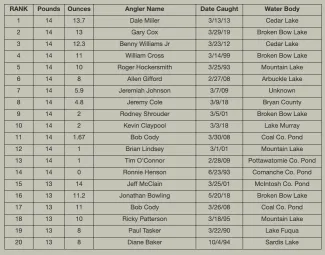
The season of lunker bass is upon us! While the outside temperatures are chilly to down-right frigid, the days are beginning to lengthen and beneath the surface largemouth bass are starting their pre-spawn journey.
Why is it lunker season you ask? February and March are the pre-spawn months for largemouth bass and several other fish species in Oklahoma. Female fish, the larger of the sexes, seek calorie-rich food in bulk to help develop their eggs, while male bass stock up their own fat reserves in preparation of exhausting themselves during the spawn.
That makes the biggest fish on a given body of water most vulnerable to angling pressure during this period. Fish also tend to congregate in certain areas of a given body of water creating ample opportunity for anglers to hook the largest bass of their lives.
During the pre-spawn months, largemouth bass move from their deep wintering areas into transition zones near their eventual spawning area. Look to target primary and secondary points of major creek arms or shallow bays and coves, where there are quick changes in depth, with shad and bluegill imitation lures such as lipped crankbaits, lipless crankbaits, jerkbaits, spinnerbaits, swimbaits and bladed jigs.
Also look to target funnels between bridge pylons and rip rap where main lake or creek arm areas go under a bridge into shallow backwater areas, especially after a few days of extended warm weather.
If there is a prolonged period of warm weather, work the backs of creek arms, coves and bays that have had the sun on them the longest with jigs, soft plastics and swimbaits.
Bass will move between these types of areas throughout the day over the course of several weeks, eventually making it to their spawning grounds.
In the early weeks of the pre-spawn, target transition areas closest to the main portion of the lake. As the days get longer and warmer, target transition areas farther back into the creek arms and bays/coves of a given body of water.
Utilize large profile baits and work them erratically for maximum vibration and sound. Keep your retrieve speeds slow especially in the early days of the pre-spawn period. Bass are looking for big easy meals, but they are still coming out of their winter lull as their metabolisms re-adjust.
The biggest bass will really start to become active when water temperatures begin to stabilize at or above 55° F.
Remember to always handle fish you plan to release with care! Big bass cannot support the weight of their bodies with their jaws extended when held up vertically or “lipped” for a photo. Fish should be held in a horizontal position with two hands; one under the bottom jaw and one wrapped around the tail.
Make sure to share your fish photos at The Dock!
20 BIGGEST LARGEMOUTH BASS CAUGHT IN OKLAHOMA
As illustrated in the graph below, 17 of the 20 biggest largemouth bass caught in Oklahoma came during the months of February (2) and March (15).

LARGEMOUTH BASS FISHING TIPS
During the pre-spawn, largemouth bass will begin to move from their wintering areas in deep water to transition areas (areas of rapid depth change) near their spawning habitat. There they will begin to gorge on available forage, primarily calorie-rich baitfish such as shad, in preparation of the spawn.
Good lure selections for targeting pre-spawn bass include swimbaits, jerkbaits, spinnerbaits, lipped crankbaits and lipless crankbaits fished in 6-20 feet of water around transition areas.
Spawning activities begin as water temperatures reach 62˚F to 65˚F.
During the spawn, focus your efforts in shallow, sheltered water where male fish will build nests.
Largemouth bass become extremely aggressive, fending off any perceived threats near a nest, particularly the male fish. This is a great time to pitch soft plastic baits such as lizards, tubes, worms, crawfish and baby brush hogs on a skirted jig or bladed jig, drop shot setup, off-set hook with a bullet weight (Texas rig), or bottom bounced (Carolina rig). Cast parallel with the bank, making long slow retrieves.
There is usually a post-spawn lull, where fish attempt to recover from the energy expended during the spawn and the bite can be slow for a week or so on a given body of water.
As water temperatures rise into the 70s, some largemouth bass will form loose schools in open water, over vegetated flats, in the main lake portions and creek channel areas.
Some largemouth bass will seek areas that have lots of different structure and cover features in a small zone, so they can move throughout the day to rest and feed without expending too much energy. Docks that have lots of vegetation and rapid depth change underneath are a great starting point.
The late spring is a good time to start working topwater baits during the low light hours.
